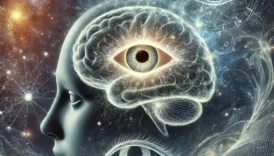THE POWER OF HYPNOSIS AND THE SUBCONSCIOUS MIND
The human mind is a vast universe filled with mysteries that have fascinated scientists and thinkers for centuries. Hypnosis and the subconscious mind are two powerful concepts that unlock the doors to this universe, deeply influencing human behavior, beliefs, and perceptions. In this comprehensive article, we will explore the definition of hypnosis, its history, the mysteries of the subconscious mind, and the therapeutic applications of hypnosis in modern times. Supported by academic references and real-life examples, this article will serve as a guide for readers to embark on a journey into the depths of their minds.
Hypnosis is often misunderstood and surrounded by myths in popular culture, but it is, in fact, a complex and layered state of mind. The subconscious, on the other hand, is a vast repository of thoughts, behaviors, and emotions that influence our daily lives without us being aware of it. The intersection of these two concepts reveals the hidden dimensions of human psychology and offers powerful tools for unlocking human potential.
- THE POWER OF HYPNOSIS AND THE SUBCONSCIOUS MIND
- 1. THE FOUNDATIONS OF HYPNOSIS
- 1.1 What is Hypnosis?
- 1.2 History of Hypnosis
- 1.3 Principles of Hypnosis
- 2. THE POWER OF THE SUBCONSCIOUS MIND
- 2.1 What is the Subconscious Mind?
- 2.2 How the Subconscious Mind Works
- 3. THE INTERACTION BETWEEN HYPNOSIS AND THE SUBCONSCIOUS
- 3.1 How Hypnosis Accesses the Subconscious Mind
- 3.2 Mechanisms of Suggestion and Areas of Application
- 4. SCIENTIFIC RESEARCH AND EVIDENCE
- 4.1 Psychological and Physiological Effects of Hypnosis
- 4.2 Clinical Studies on Hypnotherapy
- 5. MODERN APPLICATIONS AND THE FUTURE OF HYPNOSIS
- 5.1 Therapeutic and Clinical Applications
- 5.2 Alternative Medicine and Complementary Therapies
- 5.3 The Future of Hypnosis Research
- 6. A JOURNEY INTO THE DEPTHS OF THE MIND
- 7. REFERENCES
Understanding the power of hypnosis and the subconscious mind is crucial not only for personal development but also for therapeutic practices, learning processes, and fostering creativity. In this article, we will delve into how hypnosis works, how the subconscious mind operates, how they interact, and their significance in modern science.
1. THE FOUNDATIONS OF HYPNOSIS
1.1 What is Hypnosis?
Hypnosis is a state of deep focus and heightened suggestibility in which a person experiences a temporary shift in their conscious awareness. In this state, the critical faculties of the mind are subdued, allowing direct access to the subconscious. This state enables positive suggestions and new learning to take root more effectively (Erickson, 1982).
1.2 History of Hypnosis
The roots of hypnosis date back to ancient civilizations:
- Ancient Civilizations: Trance-like states were used in ancient Egypt, Greece, and India by healers and shamans for therapeutic purposes.
- Franz Mesmer and Mesmerism: In the late 18th century, Austrian physician Franz Anton Mesmer proposed the theory of “animal magnetism” and laid the foundation for modern hypnosis.
- James Braid and Modern Hypnosis: In the 19th century, Scottish surgeon James Braid scientifically defined hypnosis as a neurological state and coined the term “hypnotism,” establishing a medical perspective on hypnosis.
1.3 Principles of Hypnosis
The effectiveness of hypnosis is based on several key principles:
- Concentration and Focus: During hypnosis, the individual becomes deeply focused on internal experiences.
- Suggestibility: The individual becomes more open to suggestions, facilitating behavioral and cognitive changes.
- Mind-Body Connection: Hypnosis demonstrates how mental suggestions can lead to physical responses, useful in pain management and stress relief.
2. THE POWER OF THE SUBCONSCIOUS MIND
2.1 What is the Subconscious Mind?
The subconscious mind stores thoughts, emotions, memories, and habits that shape our behaviors without conscious awareness. Sigmund Freud described the subconscious as a reservoir of repressed desires and experiences. However, modern psychology views the subconscious as a hub for creativity, problem-solving, and automatic learning processes (Kihlstrom, 2005).
2.2 How the Subconscious Mind Works
The subconscious mind plays a crucial role in influencing our thoughts, feelings, and actions:
- Automatic Behaviors: Habits and routines, such as driving or typing, are managed by the subconscious.
- Emotional Memory: Early life experiences stored in the subconscious influence adult behavior and relationships.
- Creativity and Intuition: Innovative ideas often emerge from subconscious connections and patterns.
- Belief Systems: Core beliefs, whether positive or negative, are stored in the subconscious and shape our self-image and worldview.
Scientific studies highlight that the subconscious not only reflects past experiences but also shapes future behaviors and expectations (Barber, 2007).
3. THE INTERACTION BETWEEN HYPNOSIS AND THE SUBCONSCIOUS
3.1 How Hypnosis Accesses the Subconscious Mind
Hypnosis is a direct channel to the subconscious mind. During hypnotherapy, suggestions bypass the critical conscious mind and reach the subconscious, enabling deep-seated changes. This process is effective in treating various behavioral and emotional issues by addressing their root causes.
For example, hypnotherapy has been found effective in helping individuals quit smoking, manage weight, and overcome phobias by reprogramming subconscious patterns (Hammond, 2010).
3.2 Mechanisms of Suggestion and Areas of Application
In a hypnotic state, suggestions are accepted more readily by the subconscious mind. The effectiveness of suggestions depends on the individual’s suggestibility, the quality of the hypnosis, and the therapeutic relationship.
Common Applications of Hypnosis:
- Therapeutic Use: Hypnotherapy is used for anxiety, depression, and PTSD treatment.
- Pain Management: Hypnosis reduces pain perception and is used for chronic pain and childbirth.
- Behavioral Change: Effective in breaking habits such as smoking or overeating.
- Performance Enhancement: Athletes and professionals use hypnosis to improve focus and manage stress (Hilgard, 1965).
4. SCIENTIFIC RESEARCH AND EVIDENCE
4.1 Psychological and Physiological Effects of Hypnosis
Scientific research using brain imaging techniques has revealed the neurological basis of hypnosis. Studies show that hypnosis alters brain activity, particularly in regions associated with attention, emotion, and pain perception (Oakley & Halligan, 2013).
Brain imaging has shown that hypnosis:
- Enhances Focus: Increases activity in attention-regulating brain areas.
- Alters Perception: Changes the brain’s response to pain and sensory stimuli.
- Promotes Relaxation: Reduces the release of stress hormones, promoting a state of deep relaxation.
4.2 Clinical Studies on Hypnotherapy
Several clinical studies have demonstrated the efficacy of hypnotherapy:
- Pain Management: Research on chronic pain patients indicates that hypnosis significantly reduces pain and improves quality of life (Jensen et al., 2015).
- Anxiety and Phobias: Hypnosis has been effective in reducing symptoms of anxiety and specific phobias.
- Behavioral Therapy: Combined with cognitive-behavioral therapy, hypnosis is highly effective in breaking addictions and managing eating disorders (Kirsch, 1999).
These findings highlight hypnosis as a powerful tool for accessing the subconscious and driving meaningful behavioral change.
5. MODERN APPLICATIONS AND THE FUTURE OF HYPNOSIS
5.1 Therapeutic and Clinical Applications
Today, hypnosis is recognized as an integral part of holistic treatment approaches. Personalized hypnotherapy sessions address individual needs and goals, from managing chronic pain to overcoming anxiety disorders.
- Stress and Anxiety Management: Short hypnotherapy sessions can help individuals cope with daily stress and improve emotional resilience.
- Pain Control: Hypnosis offers a drug-free alternative for managing chronic pain and enhancing patient comfort during medical procedures.
- Habit Control: Effective in breaking harmful habits such as smoking, overeating, or nail-biting by reprogramming subconscious behavior patterns.
5.2 Alternative Medicine and Complementary Therapies
Hypnosis is also integrated with other alternative therapies to enhance well-being. Combining hypnosis with mindfulness and meditation can deepen relaxation and promote self-awareness.
- Mindfulness and Meditation: Hypnosis complements mindfulness practices by fostering a deeper connection between the conscious and subconscious minds.
- Performance Improvement: Athletes, students, and professionals use hypnosis to enhance concentration, boost confidence, and increase motivation (Hilgard, 1965).
5.3 The Future of Hypnosis Research
Advancements in neuroscience are paving the way for a deeper understanding of hypnosis and its potential applications:
- Neuroscientific Research: Functional MRI and EEG studies are revealing how hypnosis influences brain function and behavior.
- Personalized Therapy: Integrating genetic and neurological data into hypnotherapy can lead to more personalized and effective treatments.
- New Fields of Application: Emerging research is exploring the use of hypnosis for memory enhancement, learning acceleration, and trauma recovery.
6. A JOURNEY INTO THE DEPTHS OF THE MIND
Hypnosis and the subconscious mind represent powerful aspects of human psychology. By accessing and reprogramming subconscious patterns, hypnosis offers transformative potential for personal growth and healing.
- The Power of Hypnosis: Enables individuals to access the subconscious and create positive behavioral change.
- The Role of the Subconscious: Influences emotions, behaviors, and belief systems, often without conscious awareness.
- Scientific Validation: Modern research supports the efficacy of hypnosis in therapeutic and medical contexts.
This comprehensive exploration, from historical roots to modern applications, underscores the transformative potential of hypnosis and the subconscious mind. As research advances, new applications and therapeutic approaches will continue to emerge, expanding our understanding and use of these powerful tools.
The journey into the subconscious mind, guided by hypnosis, is not only a path to self-discovery but also a gateway to unlocking untapped potential. With the right guidance and understanding, anyone can harness the power of their subconscious to create meaningful change and improve their quality of life.
7. REFERENCES
- Erickson, M. H. (1982). The Collected Papers of Milton H. Erickson on Hypnosis. Irvington.
- Braid, J. (1843). Neurypnology: The Rationale of Nervous Sleep, Considered in Relation with Animal Magnetism. John Churchill.
- Kihlstrom, J. F. (2005). The Cognitive Unconscious. Science, 309(5741), 1444-1446.
- Barber, T. X. (2007). Trance, Time, and Memory: Clinical and Theoretical Perspectives on the Nature of Hypnosis. Brunner-Routledge.
- Hammond, D. C. (2010). Handbook of Hypnotic Suggestions and Metaphors. W. W. Norton & Company.
- Hilgard, E. R. (1965). Hypnotic Susceptibility. Harcourt.
- Kirsch, I. (1999). Hypnosis and Suggestibility: An Integrative Approach. Guilford Press.
- Jensen, M. P., et al. (2015). Hypnotic analgesia and pain management: A review of clinical research. The Clinical Journal of Pain, 31(7), 643-652.
- Oakley, D. A., & Halligan, P. W. (2013). Hypnotic suggestion and cognitive neuroscience. Trends in Cognitive Sciences, 17(11), 602-609.





